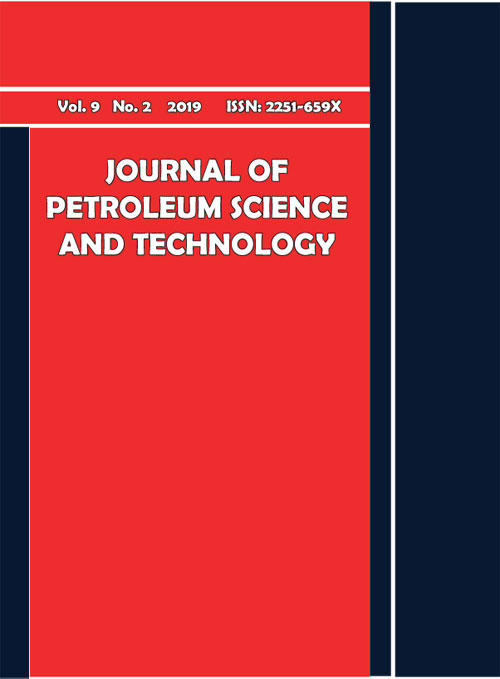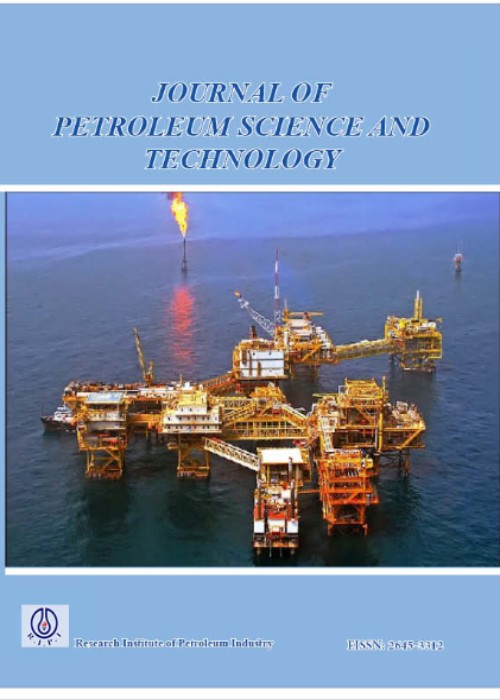فهرست مطالب

Journal of Petroleum Science and Technology
Volume:9 Issue: 2, Spring 2019
- تاریخ انتشار: 1398/03/25
- تعداد عناوین: 6
-
-
Pages 3-17Crude oils and source rocks from the Northern and offshore depobelts of the Niger Delta basin, Nigeria have been characterized based on the distribution of pyrene and its derivatives by gas chromatography-mass spectrometry. Moreover, the crude oils have been characterized by the dominance of pyrene over fluoranthene while fluoranthene generally predominated over pyrene in the rock samples. Also, 4-methylpyrene has been the dominant compound among the methylpyrene isomers in the crude oils and source rocks while benzo[a]fluorene (BaF) predominated over benzo[b]fluorene (BbF). The pyrene distribution shows that the crude oils and source rocks have been formed from mixed sources (terrestrial and marine) but with higher inputs from terrestrial organic matter. The maturity dependent parameters which have been computed from pyrene distributions indicate that the oils have been thermally matured while the rock samples have been within immature to early oil window maturity status. Finally, the crude oils and the sources of source rocks, and thermal maturities have been further confirmed by other well-established parameters computed from saturate and aromatic parameters and vitrinite reflectance.
At the end, it has been found out that the abundance and distribution of pyrene, and its derivatives have been found to be effective in determining the origin and thermal maturity of crude oils and source rocks in the Niger Delta Basin.Keywords: Pyrene, Crude Oil, Source Rocks, Niger Delta, Origin, Maturity -
Pages 18-29With significant increase of tomographic equipment power, demand for Prediction relative permeability prediction Predicting in porous media from digital image data. In this work, it is predicted three -phase relative permeabilities with co-applying Darcy’s and Stokes equations in two case studies, namely Bentheimer sandstone and Estaillades limestone which their micro-CT data files were downloaded from Imperial College website. In order to perform calculations firstly we extracted pore connected network from the micro-CT data and it is estimated fluids distribution within pore channels during two-phase flow. Then we calculated pressure distribution of each phase solving its continuity and momentum equations within the obtained connected phase network. Pressure distribution and fixed volumetric flow rate ( that flows through all cross-sections perpendicular to the supposed flow direction), then were applied to solve for effective permeabilities. Effective permeabilities were then related to the relevant saturation and curves of two -phase relative permeabilities were derived in this manner. Stone’s equation was finally applied to estimate three phase permeability ternary curves. Results showed that application of correlations for determining fluid distributions is accurate enough for multiphase relative permeability estimation in real case studies. This paper also shows that performing calculations on the segmented REVs is more accurate than work on simplified pore network models extracted from micro-CT data.Keywords: Relative Permeability, Micro-CT, Multiphase Flow, Reservoir Rocks
-
Pages 30-45In this work, SO2 adsorption on 13X and 5A was explored at different concentrations, and the results were compared to molecular simulation and models. The adsorbent saturation tests were performed at four different concentrations of 250, 500, 750, and 1000 ppm, and it was observed that saturation would take more time for higher SO2 concentrations. Grand Canonical Monte Carlo method was used for simulation. In addition, extra framework cations of Na were used 13X structure and Na and Ca Cations were used in 5A structure. The results of the simulation were compared to experiments. The effect of water molecule content on adsorption was determined by inserting a different number of water molecules. Also, the outcome of experiments and simulations were in good agreement. The results showed that 13X is a better adsorbent for SO2 than 5A. 13X zeolite with 96 water molecules and 5A with 99 were provided the best prediction of experimental results. Yoon-Nelson and BDST models were also used to find the rate of adsorption capacity reduction related to breakthrough curve and loading amount. The results of the two model suggested that 13X has a higher loading capacity while 5A provided longer saturation time.Keywords: Dioxide, Adsorption, Molecular Simulation, Zeolite, 13X, 5A
-
Pages 46-53
Formation of natural gas hydrate is a serious problem in the gas and oil industry because it can plug pipelines and destroy the equipment. This study aimes to evaluate the concentration effect of glycol ethers on their synergism with a commercial kinetic hydrate inhibitor (Luvicap 55W) in sweet natural gas-water systems at a constant temperature of 4 oC and pressure of 95 bar. Hydrate formation experiments have been designed and conducted in a static, stirred autoclave. Finally, the results indicated that concentration changes dosen’t affect the inhibition time greatly, while the growth rate of hydrate crystals decreases considerably with the increase in the concentration of glycol ethers.
Keywords: Hydrate, Natural Gas, Synergistic Effect, Kinetic Inhibitor, Glycol Ethers -
Pages 54-69Understanding and modeling of three-phase transient flow in gas-condensate wells play a vital role in designing and optimizing dynamic kill procedure of each well that needs to capture the discontinuities in density, geometry, and velocity of phases but also the effect of temperature on such parameters. In this study, two-phase Advection-Upstream-Splitting-Method (AUSMV) hybrid scheme is extended to a three-phase model capable of modeling blowout and dynamic kill in gas-condensate-water wells. In order to better understand and model such a process, density and viscosity changes are calculated using the Peng-Robinson equation of state. Moreover, the resulted simulator enables us to study and model highly changing flow conditions during blowout and dynamic kill process applied to a well in a gas condensate reservoir. In addition, a sensitivity analysis has been conducted on the relief well kill rate, pump step down schedule, and well intersection depth. Moreover, the results reveal the impact and influence of each of these parameters on dynamic kill process. Finally, the model introduced here and the results of the sensitivity analysis using this transient three-phase model can be used to better design a control process for wells in gas condensate reservoirs.Keywords: Three Phase Modeling, Dynamic Kill, Gas-Condensate Well, Advection Upstream Splitting Method, Hybrid Scheme
-
An Effective EOS Based Modeling Procedure for Minimum Miscibility Pressure in Miscible Gas InjectionPages 70-88The measurement of the minimum miscibility pressure (MMP) is one of the most important steps in the project design of miscible gas injection for which several experimental and modeling methods have been proposed. On the other hand, the standard procedure for compositional studies of miscible gas injection process is the regression of EOS to the conventional PVT tests. Moreover, this procedure does not necessarily result in an accurate calculation of the MMP. In this study, an effective procedure is presented using both conventional PVT and slim tube data in the regression to provide appropriate EOS parameters for field studies including miscible gas injection. In the first step, the EOS parameters were subjected to regression to the conventional PVT data. In addition, these parameters were then used as inputs for simultaneous regression to the conventional PVT and MMP data. MMP is modeled through the automated execution of a series of compositional simulation of slim tube. Moreover, the regression uses a stochastic optimization for minimizing an objective function (regression) have been coupled with two separate core calculations, (1) equilibrium calculations of the conventional tests and (2) compositional simulation of the slim tube. For evaluation, a number of real reservoir fluids from field data are used from reliable datasets in the literature. Finally, the promising results demonstrated that this procedure is capable to provide EOS parameters for accurate predictions in the miscible gas injection processes.Keywords: Reservoir Fluids, Minimum Miscibility Pressure, Compositional Simulation, Regression, Slim Tube


